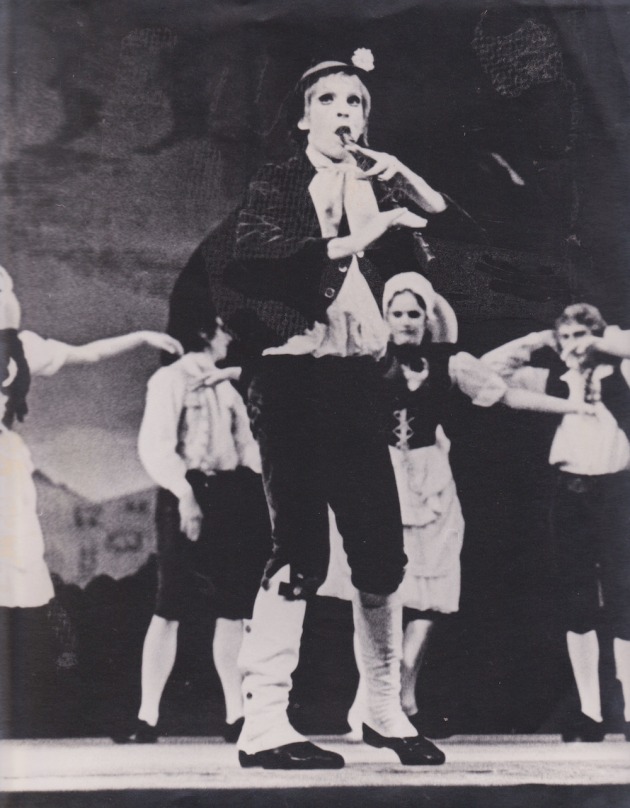Alan Richard Alder
Born: Canberra, 1937
Died: Bayswater, WA, aged 81
Alan Alder was one of the finest dancers of his generation, and without peer as a character actor. His performance record included a spoiling-for-a-fight Tybalt in John Cranko’s Romeo and Juliet, a vengeful Hilarion in Giselle, the puppet with a human heart in Petrouchka. He was equally at home in contemporary work such as the Moorish slave, Sebastian, in John Butler’s ballet of the same name, a glistening athlete in Butler’s Threshold, premiered by The Australian Ballet in 1968, and an obsequiously evil Iago in Garth Welch’s Othello (1971).

He will be best remembered, however, for his portrayal of Alain, the simpleton son to a wealthy vigneron, in Frederick Ashton’s La Fille Mal Gardée. The sight of him hobby-horsing a furled umbrella across the stage would have prompted Marcel Marceau to Bip his lid. It was a role Alan first performed with the Royal Ballet in London before recreating it when he returned home in 1963 to join the Australian Ballet. It was a role he had made his own.
Choreographer Barry Moreland says, “Alan was a terrific dancer-actor. He had a commanding stage presence, an immaculate sense of timing and a total immersion in the roles he played.” For Alan, Moreland created the roles of Lord Capulet in his Romeo and Juliet, and the father of Marguerite Gautier in Lady of the Camellias, two works Moreland created for West Australian Ballet during his 14-year artistic directorship.
Alan Richard Alder was born in Canberra on 14 September 1937, a son to Richard Alder, a chef at Parliament House, and Edna (née Crawley) a receptionist. He matriculated, chose not to go to university, completed national service, and joined the Department of Foreign Affairs for a year. He had shown early interest in learning tap and Scottish highland dancing from June Hammond before studying ballet with Barbara Todd. A scholarship took him to the Royal Ballet School in 1957 before spending time with Covent Garden Opera Ballet. He joined the Royal Ballet in 1958, beginning a long association with Swan Lake, from corps de ballet to soloist, and for the next four years, toured extensively through Europe, Australia and New Zealand, Japan and South Africa.

The founding artistic director of The Australian Ballet, Peggy van Praagh, invited him to join as a senior soloist in 1963, and he was promoted to principal artist in 1969. In 1972 he married internationally acclaimed ballerina, Lucette Aldous. They were then invited by the Soviet Ministry of Culture to study teaching methods in St Petersburg. Over four months, in late 1975, they studied the Vaganova system of training under the guidance of those who had taught Rudolf Nureyev. Their daughter Floeur, who was to become a talented dancer, choreographer and Churchill Fellowship holder, was born in Melbourne in 1977. Alan continued as a guest artist with The Australian Ballet until he retired in 1979, when his almost 17 years was the longest unbroken tenure of a dancer in the company.
Alan and Lucette taught at the Victorian College of the Arts, and at the Australian Ballet School with Dame Margaret Scott and Anne Woolliams. Then, in 1983, Alan accepted an appointment as Head of Dance at the West Australian Academy of Performing Arts (WAAPA), the same year that Moreland was appointed artistic director of West Australian Ballet, then a company of 12 dancers. It was the beginning of a fruitful and creative partnership.
“I could always count on Alan’s cooperation to provide students for the full-length ballets in the repertoire — Romeo and Juliet, Cinderella, Giselle, Nutcracker,” says Moreland. “Without the support of the Academy these works would not have been possible.”
Alan and Lucette set a high standard of teaching, and during his nine years at WAAPA, produced a crop of outstanding dancers, among them: Felicity Bott, Daryl Brandwood, Michael Campbell, Margrete Helgeby, Elizabeth Hill, Michelle Martin and Brett Roberts. Graduates have had significant careers, in Australian or international companies, as performers, choreographers, company managers and artistic directors.

Under Alan’s leadership, a two-year Associate Diploma was diversified into six courses, from Certificate to Degree, that catered for teachers, performers, Aboriginal students, as well as physical education instructors. There was a corresponding growth in full-time, part-time and visiting teaching staff. One part-time staff member, Spanish specialist Deanna Blacher, went on to form a successful company, Danza Viva, that included Academy graduates. Chrissie Parrott choreographed Impasse and Blackbird at WAAPA, subsequently taken into WA Ballet’s repertoire. WAAPA graduates joined her own company. In 1987, 12 WAAPA dancers represented Australia in the International Festival of Dance Academies in Hong Kong.
In 1991, when his contract expired, Alan was not reappointed as Head of Department but was offered a teaching position, which he declined. This management decision, made behind closed doors, left a bitter taste. Alan continued to teach privately.
Under Alan, the WAAPA Dance Department had formed close links with Ausdance WA, and after leaving WAAPA, he became a long-serving member of its management committee and also served as State Vice-President (1990-2006). In 2004, Alan and Lucette were recognised as State Living Treasures, and in 2009 he was honoured with an Ausdance WA Lifetime Achievement Award.
Alan died of a rare, aggressive cancer on 15 July 2019. He is survived by Lucette, Floeur and her partner Adam Graham, and Alan’s younger sister, Joy. Two photographs of him by Janice McIllree—one brooding, one raffish—hang in the National Portrait Gallery, Canberra.
- David Hough



